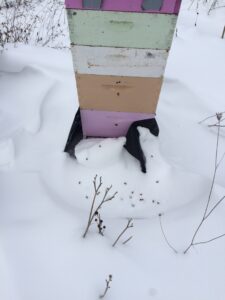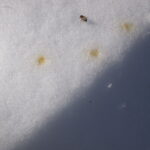It’s the first week of January and we still have all but one of our hives alive, knock on wood!
How do we know this? We knocked on wood.
We’ve been (dreadfully) missing both our bees and sunshine, so when the clouds parted January 4, we did what I recommend all Michigander beekeepers do at least monthly: we checked on all our bees.
Upon chatting with my mentees, many of them missed the memo about having to check bees in the winter. The reasons to do so are two-fold:
- There are actions you can take to help keep them alive and
- If you suspect they’re dead, while there’s nothing you can do about it now, you can make plans to obtain more bees while suppliers are still taking orders (typically through the end of February, supplies permitting)
Back to checking bees …
Our first check is the outside of each hive, looking for anything “odd.” For us, this might include tracks into but not out of the hive, a branch that could break under heavy snows or winds and knock over the hive, or one of the many hive tools I misplaced last fall.

Perhaps those scattered outside the hive were deceased sisters flown out and dropped; perhaps those were bees on a cleansing flight who became too cold to return … or too disoriented in the bright light of sunshine to find their way back.
You might find a dozen or so dead bees about the outside. We had a dusting of snow the day we checked, making it easy to see any. Bees die in the hive throughout the winter from old age, and if the cold isn’t forcing them to cluster tightly for warmth, the dead will be removed to just outside the door—assuming the door isn’t blocked, more on that later.
Seeing a few dozen is very normal; seeing none may warrant further investigation, like—does it mean there is no one alive inside to remove the dead bees, weather permitting of course? If there’s enough snow, you may also see these amber-brown spots. Bees won’t relieve themselves in the hive if they can help it, and can go for weeks if the weather doesn’t allow them to take a cleansing flight.

LOVE seeing these spots! They’ve broadened as they melt into the snow, but they’re a sign that a live bee feels quite relieved.
We next attempted to determine if anyone was alive in each hive. For each, we put an uncovered ear on the outside, about the middle of the stack of boxes. Remember, bees typically start at the bottom in the fall, and eat their way to the top over the winter. With such a warm last of 2015, we assumed the cluster would be hanging out at least up to the middle boxes of our three and four box tall colonies.
If we heard nothing by merely putting an ear to the box, we rapped sharply on the side. The response varied because of factors like:
– Size of the cluster—a strong (or really irritated?) cluster roars back. Often you can hear them without even knocking.
– Temperature—they’re huddled closer the colder it is; they may be scattered throughout on a warmer day, or many up top working that emergency food ceiling you installed (you installed one, right? If not, we need to talk about now what.)
– Location in the boxes—you might put your ear against the lower right side and they’re actually upper left…but there’s no way to know without a temperature scope or opening the hive (generally a no-no in the winter)
– Ambient noise—a fleet of fighter jets never fails to repeatedly circle when we’re concentrating to hear bees
What might you hear?
Sometimes there’s that reassuring roar / buzz. Other colonies, you hear a loud shudder, almost like an explosive intake of breath. Then there are colonies where there’ll be a wee murmur, which might be because they’re dwindling in number, occupied watching videos, or the cluster was located quite far from where my ear was pressed. For wee murmur colonies, I rejoiced at hearing at least something, but said extra prayers.
And then, there may be the colonies where you hear nothing, sigh. THAT DOES NOT MEAN THEY’RE DEAD. In fact, even when you’re quite sure they’re dead, THAT DOES NOT MEAN THEY’RE DEAD, but more on that later.
Whatever you do (or do not) hear, make a note of it. Hearing nothing each hive check may be an indicator that things are definitely awry, and when weather allows (March?) you may want to open up and check further. I’ll write more about dealing with dead-outs when the time comes.
Our next hive check is at the entrance. We’ll clear any snow or ice so air can flow into the hive.
We also clear the inevitable dead bees from the bottom board. We scrape them out using a long stick (or a handy driveway marker—the ones you forgot to put in last fall when the ground was soft.) When weather allows, dead bees will decompose—not a healthy thing. Plus, scraping them out saves the bees that labor, and allows for better air flow. Remember, ventilation is key. Bees can better survive cold if they’re not wet and cold, and a colony trying to keep warm generates lots of moisture.
Speaking of air flow, dead bees will block it, as will snow. Thus, it is critical to have an upper entrance (or two or three) in each colony. Way back in the fall we drilled a 5/8” hole in each box, on the non-prevailing wind side. While you’re doing your winter hive checks, verify that the hole is still open (ie, no dead bees or a dead rodent stuck in it.) Didn’t drill a hole? Not too late yet …

Speaking of dead rodents, I scraped out that curly tailed critter. It was quite dead, as were the dozen or so bees lodged in its fur who stung it to death. Sorry to lose that many bees; not sorry about the dead mouse.
I also surmise the mouse crawled in through the entrance reducer, because according to the internet, a mouse can pretty much go anywhere a #2 pencil can go. Next time you’re lying awake listening to weird scratchy noises, for fun ponder how many small holes you have in your home. 🙂 And remember, there are always plenty of cats available for adoption.
Finding dead rodents is not normal, but it happens, and hopefully doesn’t lead to bigger issues. A rodent can eat most of a colony’s stores, and if the bees are clustered for warmth, it has free reign. Luckily, weather has allowed bees to frequently break cluster and move about to stores (or to sting invaders), so if a critter wanders into your hive, hopefully it is stung to death before it can do too much damage.
Scraping out dead bees is normal, but what’s a normal amount to remove? The photo shows what I suspect is too many. I doubt that hive will make it much longer, but there’s nothing to be done about that now (other than start driving it to Florida.) In most hives, I scraped out between a few dozen and a cup full.

This hive was still alive, but that’s a huge amount of dead bees to scrap out in early January, especially since I did the same about a month earlier. Sigh.
So, about dead hives …
First it happens, and more often—to newbees because there’s so much to learn. If you lose a colony, please honor them by getting back on the horse and trying again … as well as pondering / researching / studying to figure out how to better succeed. Your bees next season will have the bonus of starting on drawn comb, so that’ll help improve the odds in your favor.
Earlier, I warned that a hive you think is dead may not be. All beekeepers who have been in this a few years have had dead hives, and most of us have grand and humorous stories about hauling them in to clean-up the boxes, only to have what appeared to be dead bees warm up and stingingly letting us know they’re very much alive in a small or very quiet cluster.
IF the hive is dead, no need to confirm it yet. You really can’t / shouldn’t do anything about it until it is warmer. Moving frozen boxes will crack the wax, ruining the precious drawn comb. More importantly, the bees may be alive in there even though it is quiet. Opening them up and going thru them (unless it is warm and sunny) will harm them, so you can’t verify if they’re dead or not unless you truly want to kill them. Again, all that really can be gained by knowing if they’re dead or alive now being able to order replacement bees.
As a final note, Oct-Nov-Dec were unusually warm, so when weather allows, do a hive check of that sugar ceiling. Whether you Mountain Camped or candy boarded, you may find they’ve already eaten much of it because the warm weather has allowed them to be active. It may be weeks or months before we have a sunny, 50-degree day, so if we have a low-wind 40ish day, you may quickly crack the top and take a peek. (And wear at least a veil, because when you surprise them they may attack.) Be prepared to take action should they need more stores—like have a sugar patty at the ready to slide in. It is a long way from now until Spring, and historically most Michigan bees die in March from starvation.
As usual, all of this is just one beekeeper’s experience and insight. Read, research, ponder, because keeping bees is a lifelong journey of learning.
And let me know of any questions. If I can’t work bees now, at least I get to talk about them!
